The Des Moines River is a little over 500 miles long. The section I spend most of my time on is maybe a mile. Probably a little less than that. It’s an urban section of river; there’s nothing ‘natural’ about it. There aren’t any real river banks, there are no trees lining the water, there are no organic eddies or sandbanks or mudflats. There are concrete walkways and arched bridges and dams and promenades and buildings. You can buy a coffee (or a beer or a glass of wine) in a small kiosk and sit and watch the water roll on.
I do that fairly often. When I do, I usually find myself looking at the river and wondering what it must have been like before.  Before, this was French territory. Most folks think of North America as a former British colony, which is a limited version of the truth. In fact, the British were largely confined to a relatively narrow strip of land along the Atlantic coast. Most of the interior was held by the French. Well, actually it was held by the native tribes who lived there before any Europeans made their way across the ocean. But history was written by Europeans, so it’s mostly concerned with what Europeans did.
Before, this was French territory. Most folks think of North America as a former British colony, which is a limited version of the truth. In fact, the British were largely confined to a relatively narrow strip of land along the Atlantic coast. Most of the interior was held by the French. Well, actually it was held by the native tribes who lived there before any Europeans made their way across the ocean. But history was written by Europeans, so it’s mostly concerned with what Europeans did.
My point, if you can call it that, is this: Iowa used to be part of Nouvelle-France. New France was fucking HUGE. It stretched west from Newfoundland all the way to the Great Plains (and, eventually, clear to the Rocky Mountains). It included all the land south of Hudson Bay down to the Gulf of Mexico. The entire drainage basin of the Mississippi River comprised a district called Louisiana, which was divided into Haute Louisiane and Basse-Louisiane. Upper and Lower Louisiana. Sort of like North and South Dakota, only with the benefit of not being either of the Dakotas.  Of course, the native peoples didn’t give a moose’s ass what the French called the land. I suspect they just stood around grinning and snickering to themselves while these odd white guys kept ‘discovering’ places and renaming them. The first white guys set foot in what eventually became Iowa in 1659. Pierre-Esprit Radisson and his brother-in-law Médard des Groseilliers. Despite their poncy names, these guys were tough. They were coureurs de bois — runners of the woods. Unlike voyageurs, who were licensed to do business by trading companies (in other words, capitalist lackeys), coureurs de bois were independent, entrepreneurial fur-trappers, traders, and explorers.
Of course, the native peoples didn’t give a moose’s ass what the French called the land. I suspect they just stood around grinning and snickering to themselves while these odd white guys kept ‘discovering’ places and renaming them. The first white guys set foot in what eventually became Iowa in 1659. Pierre-Esprit Radisson and his brother-in-law Médard des Groseilliers. Despite their poncy names, these guys were tough. They were coureurs de bois — runners of the woods. Unlike voyageurs, who were licensed to do business by trading companies (in other words, capitalist lackeys), coureurs de bois were independent, entrepreneurial fur-trappers, traders, and explorers.
Radisson and des Groseilliers explored and mapped a big chunk of the North American interior. Radisson eventually had three or four towns named after him, and a hotel chain, and even a Canadian Coast Guard vessel. Nobody named anything after Médard des Groseilliers. This is what happens when you partner up with a guy whose name is more cool than yours. But even though these men made their way to Iowa, they almost certainly didn’t travel up the Des Moines River. 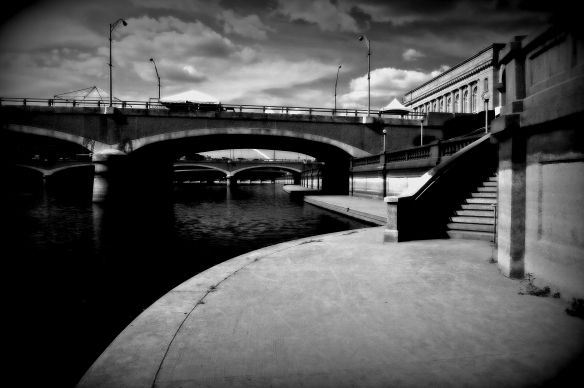 Nobody really knows which European made the first trip up La Rivière des Moines. It could have been Michel Accault, Antoine Angel, and Father Hennepin in 1680; they were in the area. Or maybe it was the cartographer Jean-Baptiste-Louis Franquelin a few years later, though it’s more likely he copied some other guy’s map of the river. The Baron Louis-Armand de Lom d’Arce de Lahontan said he traveled up the Des Moines, but most historians think he was lying about it. We know that Pierre Charles Le Sueur made his way up the river in 1700, but he probably wasn’t the first. A few years after Le Sueur, Father Peter Francis Xavier de Charlevoix wrote this:
Nobody really knows which European made the first trip up La Rivière des Moines. It could have been Michel Accault, Antoine Angel, and Father Hennepin in 1680; they were in the area. Or maybe it was the cartographer Jean-Baptiste-Louis Franquelin a few years later, though it’s more likely he copied some other guy’s map of the river. The Baron Louis-Armand de Lom d’Arce de Lahontan said he traveled up the Des Moines, but most historians think he was lying about it. We know that Pierre Charles Le Sueur made his way up the river in 1700, but he probably wasn’t the first. A few years after Le Sueur, Father Peter Francis Xavier de Charlevoix wrote this:
[T]he river Moingona issues from the midst of an immense meadow, which swarms with Buffaloes and other wild beasts
Swarms of buffalo where there are now coffee shops. How cool is that? The buffalo are gone now, other than a few small herds kept in parks so sticky-fingered children can look at them. The buffalo are gone, and so are the French. 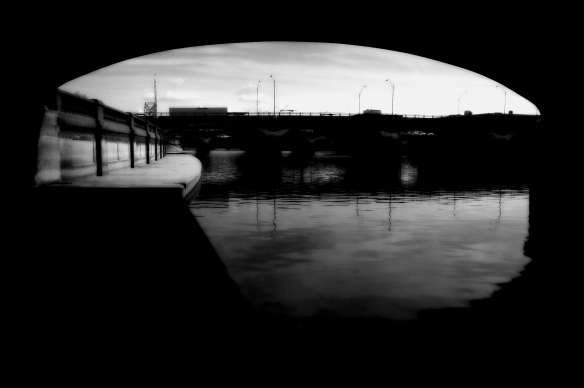 We know why the buffalo are gone. Because we were well-armed murderous bastards and we slaughtered them for our amusement. But why did the French leave? They had a massive presence in the New World — not just all that territory in North America, but throughout the Caribbean. That’s why pirates in the movies (the ‘bad’ pirates, not the good Errol Flynn pirates) always speak with a French accent — because they fucking owned Hispaniola. So why did the French leave? Give some of the credit to François-Dominique Toussaint Louverture, a slave born on Hispaniola.
We know why the buffalo are gone. Because we were well-armed murderous bastards and we slaughtered them for our amusement. But why did the French leave? They had a massive presence in the New World — not just all that territory in North America, but throughout the Caribbean. That’s why pirates in the movies (the ‘bad’ pirates, not the good Errol Flynn pirates) always speak with a French accent — because they fucking owned Hispaniola. So why did the French leave? Give some of the credit to François-Dominique Toussaint Louverture, a slave born on Hispaniola.
In 1791 Louverture took the island away from the French by leading a successful slave rebellion. That pissed off the French and a decade later Napoleon Bonaparte sent a sizable military force to New Orleans to support an effort to re-take Hispaniola. The United States was only about 15 years old at the time, and having the French military camped out in New Orleans made the government nervous. Almost half of the goods imported into the U.S. passed through the port of New Orleans. So even though the French failed to retake Hispaniola (which is now Haiti and the Dominican Republic), President Thomas Jefferson thought it might be a good idea to find a way to get the French off our stoop.
In 1803 Jefferson decided to try to buy the city of New Orleans from the French. He figured he’d offer France a cool US$10 million for the city — and what the hell, maybe some of the surrounding land. Why not? France would get a little cash in the bank, the U.S. would get a nice port and party town, everybody would be happy.
But Bonaparte was dans le pétrin — in a pickle. He’d lost the income from the sugar grown on Hispaniola, he was facing another war with Britain, and his nation was close to bankruptcy. So before the U.S. made its ten million dollar offer, Bonaparte proposed to sell ALL of Louisiana for 50 million francs (plus canceling a debt of about 18 million francs). That amounted to about 15 million dollars. Jefferson had planned to offer ten million just for the city; now he could get the entire French enchilada (yeah, I know, let’s not get bogged down in national cuisine here) for another five million. A bargain, right?
Congress opposed the purchase. Seriously. Jefferson was about to double the size of the nation — to pick up around 828,000 square miles of territory at a cost of about three cents an acre — and Congress opposed it. They said the president didn’t have the authority to make or accept the offer. They disliked the idea of granting citizenship to the French, Spanish, and free black people who lived in the territory (nobody even considered citizenship for the native peoples). They worried about the political effects of bringing in all those farmers when so much of the power of Congress depended on the wealth of the merchants and bankers along the coast.
In other words, Congress — primarily the House of Representatives — were dicks about the whole thing (sound familiar?). But the sale squeaked through in the House and was passed by the Senate, and hey bingo, the United States was suddenly bigger and in a position to start seriously fucking over the native peoples west of the Mississippi.
So I walk beside the Des Moines River. I sip my coffee and watch the water pass by. And I think about those courageous coureurs de bois (and they were courageous; it took some massive balls to go wandering in unexplored and often hostile territory), and I think about the European politics that eventually led the United States to the genocide of the natives who lived in the Americas (and the French were just as guilty in this; in 1729 Louis XV authorized the extermination of the Fox Indians because they were interfering with the fur trade). Half a mile south of where the photograph above was taken you can still find the remains of an old fort constructed to protect the French monks who’d come to the New World to force Baby Jesus down the throats of the natives.
So many wonderful and horrible things happened along this river. And the only thing that’s been consistent throughout is the river itself. The river doesn’t care. The buffalo were here, the Indians were here, the French were here, now I’m here.
Given that history, I don’t think this ends particularly well for me.

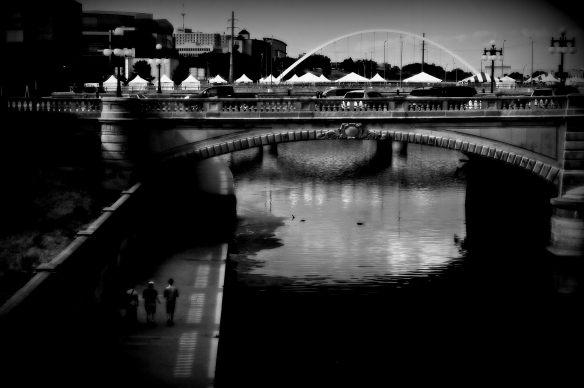
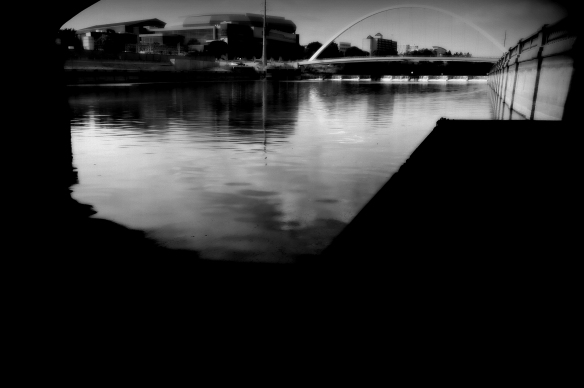
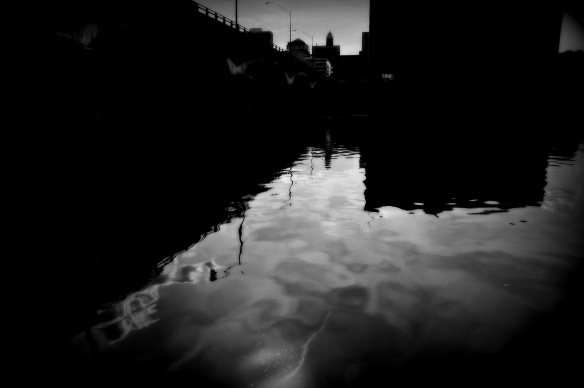
When was all that infrastructure built…the beautiful bridges and walkways? I wish the LA River were as pretty.
LikeLike
Jody, the original construction of the riverwalk was done in the 1930s by the Civilian Conservation Corps. You know…one of those socialist jobs programs enacted by Congress during the Depression. It was such a terrific concept — Wall Street fucked up, regular folks suffered, so the government put them to work improving communities, which not only made the communities better, but gave folks money to pay their bills and buy stuff, which increased private sector employment and helped end the Depression. You’d think Congress would consider doing the same thing now…but no.
LikeLike
I love the way you present the history, Greg. It always comes down to just people being people in the end… And Jody, if you decided to shoot the LA river I’m sure you’d find a way to make it irresistible. :)
LikeLike
Thanks Beckett. And it IS always people being people. Ain’t it great? Ain’t it awful and ain’t it great?
LikeLike
I love the timelessness of these photos, especially the 4th one down – and your use of “moose’s ass,” which I’m going to have to steal when swearing like a sailor (which is often).
LikeLike
Lisa, I would give a shiny new nickel to hear you swear like a sailor.
LikeLike
But think of all the wonderful things you will leave behind to remind people of you… Photos, stories, memories – you will make great history.
LikeLike
I do all this stuff to amuse myself. I’m not terribly interested in what people will think after I’m dead. Hell, I’m not terribly interested in that now. But it does please me that people enjoy (or get pissed off) some of the things I do to stay entertained.
LikeLike
I love that you’ve gone all moody black and white for the French blog post.
LikeLike
I don’t often go moody black and white. I suspect it’s for the same reason I’ve never taken heroin. I’m afraid I’ll get hooked on it.
LikeLike